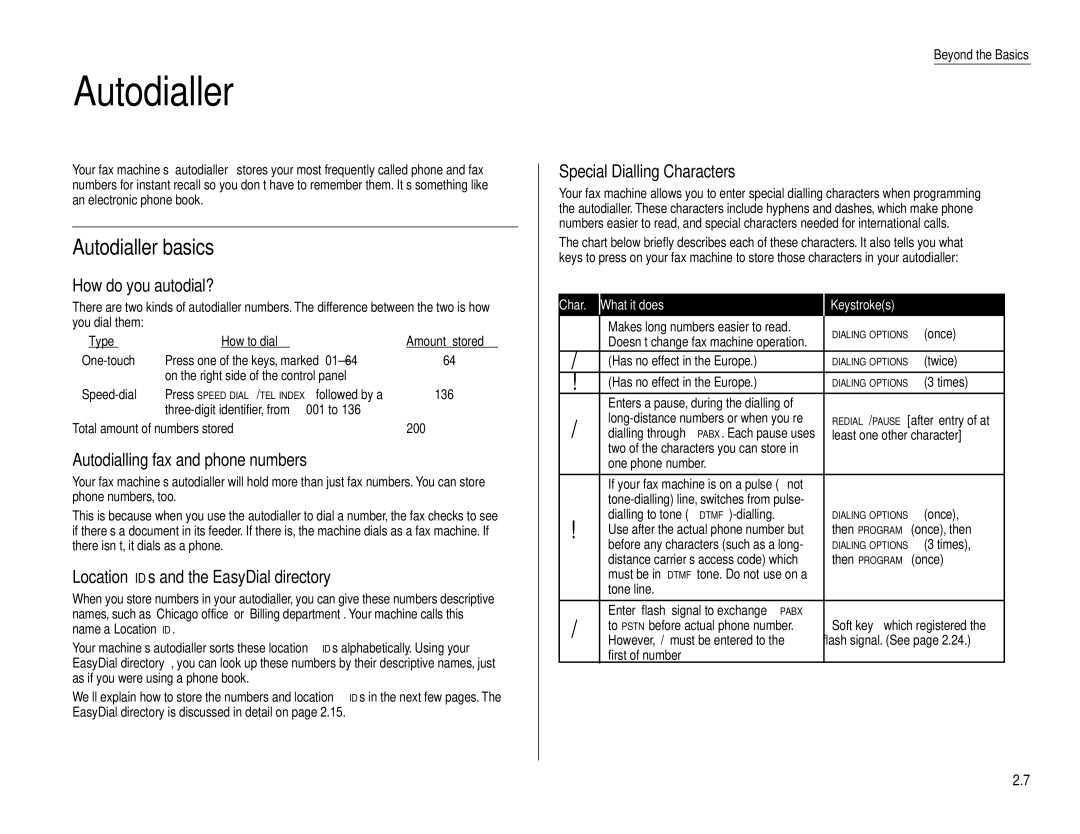
Autodialler
Your fax machine’s autodialler stores your most frequently called phone and fax numbers for instant recall so you don’t have to remember them. It’s something like an electronic phone book.
Autodialler basics
How do you autodial?
There are two kinds of autodialler numbers. The difference between the two is how you dial them:
Type | How to dial | Amount stored |
Press one of the keys, marked | 64 | |
| on the right side of the control panel |
|
Press SPEED DIAL/TEL INDEX followed by a | 136 | |
|
| |
Total amount of numbers stored | 200 | |
Autodialling fax and phone numbers
Your fax machine’s autodialler will hold more than just fax numbers. You can store phone numbers, too.
This is because when you use the autodialler to dial a number, the fax checks to see if there’s a document in its feeder. If there is, the machine dials as a fax machine. If there isn’t, it dials as a phone.
Location IDs and the EasyDial directory
When you store numbers in your autodialler, you can give these numbers descriptive names, such as “Chicago office” or “Billing department”. Your machine calls this name a Location ID.
Your machine’s autodialler sorts these location IDs alphabetically. Using your EasyDial directory, you can look up these numbers by their descriptive names, just as if you were using a phone book.
We’ll explain how to store the numbers and location IDs in the next few pages. The EasyDial directory is discussed in detail on page 2.15.
Beyond the Basics
Special Dialling Characters
Your fax machine allows you to enter special dialling characters when programming the autodialler. These characters include hyphens and dashes, which make phone numbers easier to read, and special characters needed for international calls.
The chart below briefly describes each of these characters. It also tells you what keys to press on your fax machine to store those characters in your autodialler:
Char. | What it does | Keystroke(s) |
– | Makes long numbers easier to read. | DIALING OPTIONS (once) |
Doesn’t change fax machine operation. | ||
/ | (Has no effect in the Europe.) | DIALING OPTIONS (twice) |
! | (Has no effect in the Europe.) | DIALING OPTIONS (3 times) |
| Enters a pause, during the dialling of |
|
REDIAL/PAUSE [after entry of at | ||
dialling through PABX. Each pause uses | least one other character] | |
| two of the characters you can store in |
|
| one phone number. |
|
|
|
|
| If your fax machine is on a pulse (not |
|
|
| |
dialling to tone | DIALING OPTIONS (once), | |
Use after the actual phone number but | then PROGRAM (once), then | |
| before any characters (such as a long- | DIALING OPTIONS (3 times), |
| distance carrier’s access code) which | then PROGRAM (once) |
| must be in DTMF tone. Do not use on a |
|
| tone line. |
|
|
|
|
/ | Enter “flash” signal to exchange PABX | Soft key which registered the |
to PSTN before actual phone number. | ||
| However, “/” must be entered to the | flash signal. (See page 2.24.) |
| first of number |
|
2.7
